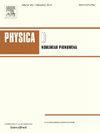用数学方法分析 p53 信号对癌细胞中 CycE/Cdk2 子系统中转录因子 E2F 表达的影响
IF 2.7
3区 数学
Q1 MATHEMATICS, APPLIED
引用次数: 0
摘要
由蛋白质和基因组成的复杂网络控制着细胞的生长,直至有丝分裂。这些成分在决定细胞中每种反应的特征和时间方面发挥着至关重要的作用。细胞周期蛋白和细胞周期蛋白依赖性激酶家族调控着细胞从一个阶段到下一个阶段的进展,而某些抑制剂则调控着细胞增殖,对这一过程产生重大影响。我们研究了p53蛋白的产生对细胞周期蛋白E/细胞周期蛋白依赖性激酶2(CycE/CDK2)子系统的影响。虽然人们对 p53 蛋白的确切功能尚不完全了解,但已知它在 DNA 损伤时会表现出脉冲式行为。因此,细胞系统中 p53 蛋白的表达会随着 DNA 损伤的严重程度而增加。为了研究这个子系统,我们建立了一个 CycE/CDK2 子系统的数学模型,以非线性常微分方程的形式呈现。我们的主要目的是确定理论上可能导致肿瘤发生的条件。我们进行了动态系统分析,研究是否存在稳定的极限循环,这表明细胞的标准运行状态。我们的研究揭示了细胞可以纠正缺陷、发生凋亡或进入静止状态的 p53 蛋白水平,以及系统出现霍普夫分岔(极限循环)的情况。这是我们研究的新颖之处,因为以前的研究主要集中在数值模拟上。我们利用 MATLAB 模拟,针对 p53 蛋白的不同表达和浓度得出了各种结果,从而评估了它对恶性细胞的影响。通过改变 p53 蛋白的浓度,我们确定了促进其自然生长、在存在缺陷活性的情况下进行自我纠正以及进入静止状态的特定细胞环境。这项研究的动机在于振荡在驱动、控制和管理细胞监督机制方面的重要作用。这项研究的动机是,振荡在驱动、控制和管理细胞监督机制方面发挥着重要作用。我们将这些方面纳入到建立一个模拟细胞运行的数学模型中。通过这项研究,我们确定 E2F 是减轻致癌活动的关键目标,可通过管理抑制剂 p53 的脉冲行为或抑制其在细胞机制内的产生过程来实现。本文章由计算机程序翻译,如有差异,请以英文原文为准。
A mathematical treatment of the impact of p53 signalling on the expression of the transcription factor E2F in the CycE/Cdk2 subsystem in cancerous cells
Complex networks of proteins and genes control cell growth until mitosis. These components play crucial roles in determining the characteristics and timing of each reaction in the cell. A family of cyclins and cyclin-dependent kinases regulates the progression of the cell from one stage to the next, while certain inhibitors regulate cell proliferation, significantly impacting this process. We examine the impact of p53 protein production in the cyclin E/cyclin-dependent kinase 2 (CycE/CDK2) subsystem. Although the precise functioning of the p53 protein is not fully understood, it is known to exhibit pulsatile behaviour, triggered in response to DNA damage. Consequently, the expression of the p53 protein within the cell system increases with the severity of DNA damage. Similarly, levels of CycE/CDK2 are substantially elevated in instances of DNA damage.
To investigate this subsystem, we have developed a mathematical model of the CycE/CDK2 subsystem, presented as non-linear ordinary differential equations. Our primary aim is to determine the conditions that could theoretically result in tumorigenesis. We conduct a dynamical systems analysis to investigate the presence of stable limit cycles, which indicate the standard operational states of cells. Our investigation reveals the levels of p53 protein at which the cell can correct defects, undergo apoptosis, or enter quiescence, and where the system exhibits a Hopf-bifurcation (limit cycles). This is the novelty of our study, as previous research has primarily focused on numerical simulations.
Using MATLAB simulations, we produced various results in response to different expressions and concentrations of the p53 protein, allowing us to assess its influence on malignant cells. By altering the concentration of protein p53, we ascertain the specific cellular circumstances that facilitate its natural growth, self-correction in the presence of defective activity, and entry into a state of quiescence.
This investigation is motivated by the significant role of oscillations in driving, controlling, and managing the cellular oversight machinery. These aspects are incorporated into developing a mathematical model that emulates cellular operations. From this research, we establish that E2F is a critical target to mitigate oncogenic activity, achievable by managing the pulsatile behaviour of the inhibitor p53 or inhibiting its production process within the cell machinery.
求助全文
通过发布文献求助,成功后即可免费获取论文全文。
去求助
来源期刊

Physica D: Nonlinear Phenomena
物理-物理:数学物理
CiteScore
7.30
自引率
7.50%
发文量
213
审稿时长
65 days
期刊介绍:
Physica D (Nonlinear Phenomena) publishes research and review articles reporting on experimental and theoretical works, techniques and ideas that advance the understanding of nonlinear phenomena. Topics encompass wave motion in physical, chemical and biological systems; physical or biological phenomena governed by nonlinear field equations, including hydrodynamics and turbulence; pattern formation and cooperative phenomena; instability, bifurcations, chaos, and space-time disorder; integrable/Hamiltonian systems; asymptotic analysis and, more generally, mathematical methods for nonlinear systems.
 求助内容:
求助内容: 应助结果提醒方式:
应助结果提醒方式:


